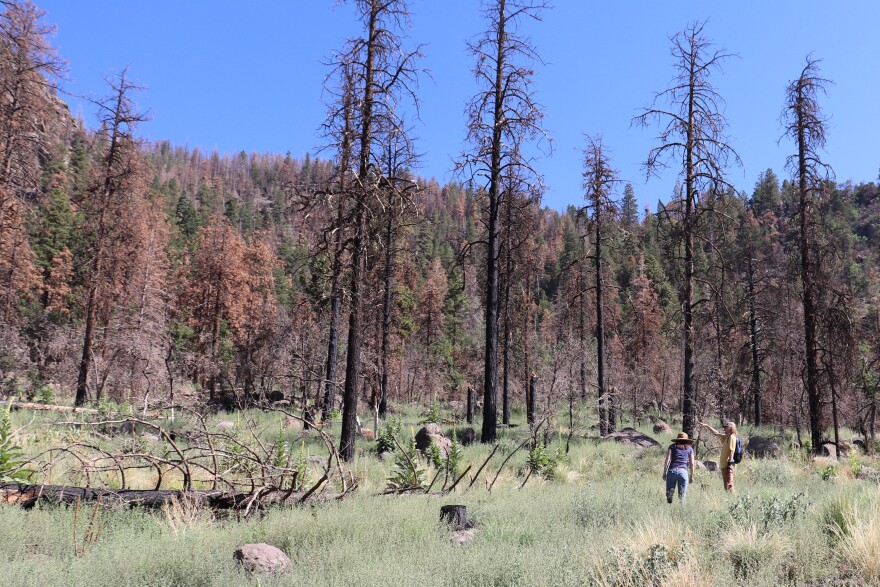Streets in east Flagstaff filled with mud and debris this week as flash floods poured down from the Museum Fire scar. The two-year-old burn scar is a study site for scientists at Northern Arizona University, who want to know how forests will recover from wildfires in a warmer, drier climate. Just before the flooding, KNAU’s Melissa Sevigny took a tour of the spot to learn about the experiment.
MITCHELL: I am Rachel Mitchell, I’m a professor in the school of earth and sustainability at NAU, and we are standing on our field site here at the Museum Fire.
TABER: I’m Ethan Taber, I’m a doctoral student in the school of earth and sustainability, studying under Rachel Mitchell.

MITCHELL: I can see probably fifty or sixty dead trees, totally dead adult ponderosa pines. The ground is covered in goosefoot and the tumbleweed, so it looks like a beautiful green meadow, but as you know when we walked up here, it was just a prickly horrible mess.

TABER: This area was complete bare mineral soil so there was no ground cover when we set up these plots. These chambers that we established create about 1 degree C of warming, that’s near-term warming, kind of what we expect to see in the next fifty years or so.
SEVIGNY: So this little square that we’re looking at, describe what it looks like.
TABER: It’s sixty centimeters tall, so it’s two feet tall by about four and a half on each side, clear plastic reinforced sheeting. Basically it traps heat on the inside during the daytime and kind of stops any wind from blowing that heat out.
SEVIGNY: Okay, so the idea is you warm up this little patch of ground and then you see what kind of plants grow there as opposed to outside of it.
TABER: Yeah exactly, and how—say we have the same plants growing inside the chamber and outside the chamber, are they different with the warming?
SEVIGNY: What have you noticed so far? What are these plants growing right now?
TABER: Looking in this plot particularly we’re seeing a lot of invasive annuals, we have a Chenopodium [goosefoot] and we have some tumbleweed going around in this area as well.
MITCHELL: Right here we have a bunch of prickly lettuce growing in this plot and basically it’s all things you don’t really want to see a lot of in the understory of the forest.
SEVIGNY: Why is that, why do you not like these plants?
MITCHELL: Our typical understories in this ecosystem should be dominated by bunch grasses. We are seeing some bunch grasses and they are adapted to fire, so when they burn, they often burn to the ground but their roots survive under the soil. With low severity fire, you get a regeneration of those grasses and the matrix of the understory should be these Arizona fescues, mountain muhly, these bunch grasses you see when you go hiking around in this area. What you wouldn’t see is a lot of these invasive annual plants, these come from somewhere else, Europe or Asia…And so they’re better able to take advantage of these atypical conditions to get a foothold in the area. They can actually outcompete our native grasses and really importantly, they can prevent pine seedlings from being able to regenerate in the area.
SEVIGNY: One important thing about plants coming back after a fire is related to flood risk. How do you feel about, looking at this field of tumbleweed, how do you feel about the flood risk in this area?
MITCHELL: One of the big things is about this area in particular and the plants we’re looking at, these are annual species, so they live, reproduce and die in a single season for the most part, which means they don’t provide a lot of flood resilience, like a perennial plant which put down roots and is there for many years, does. And so… it’s unclear to me how well these soft little annuals are going to hold the soil in place.
TABER: I do think in the short term they could definitely provide some erosion control. But then as we know, tumbleweed dries up and blows away. After that, who’s to say? Maybe back to square one.
MITCHELL: Yeah, we’re in a really unique time where fires are burning at different times and different ways and new severities and new places, and it opens up a lot of opportunity to understand how the ecosystems respond to that change.
SEVIGNY: Ethan and Rachel, thank you so much for speaking with me.
MITCHELL: Yeah, thank you very much.






